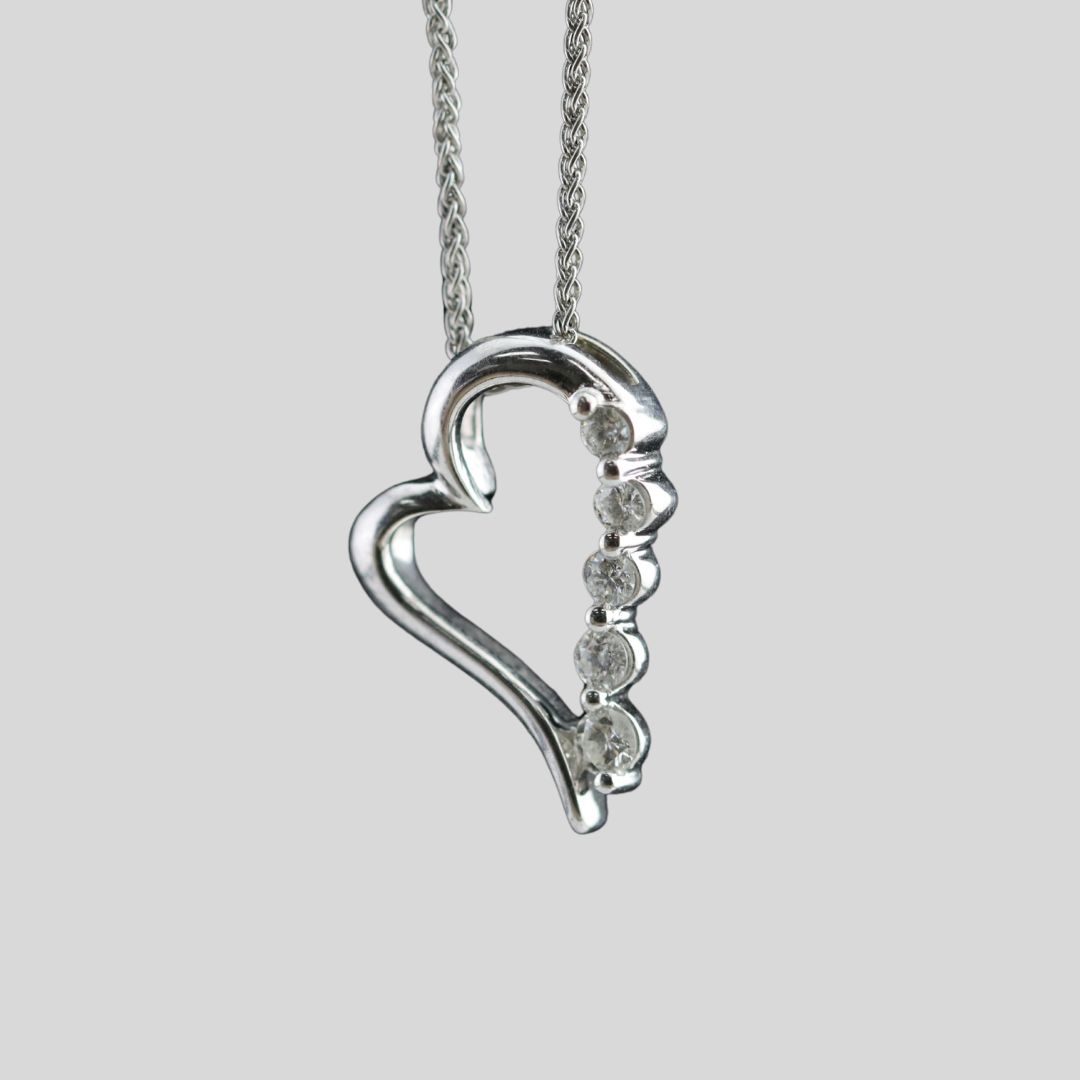Gold is one of the most iconic metals in jewelry, treasured for its brilliance, workability, and lasting value.
Pure gold (24k) is too soft for most jewelry applications, it is typically alloyed with other metals such as copper, silver, palladium, or nickel to improve durability and produce a range of colors.
At Castimize, we offer 10k, 14k, and 18k gold in yellow, white, and rose varieties, each optimized for lost wax casting.

Properties of Gold
| Color: | Pure gold is bright yellow. Alloying introduces white or rose tones |
| Hardness (Mohs): | ~2.5 Mohs (24k) to ~4.0 Mohs (14k). Hardness increases as karat decreases |
| Melting Point: | Ranges from ~879 °C (14k) to 1064 °C (24k) |
| Tensile Strength: | 120 MPa (pure) to ~300 MPa (14k/18k alloys) |
| Density: | ~19.3 g/cm³ (pure), lower for alloys (≈13–16 g/cm³) |
Why Gold Is Ideal for Lost Wax Casting
Gold’s casting characteristics are among the best in the jewelry world. It melts cleanly, with low oxidation and excellent fluidity, making it ideal for both delicate and complex designs. Its relatively low thermal conductivity (compared to silver or copper) allows molten gold to stay liquid longer within the mold, helping it reach and fill fine details before solidifying.
Casting Advantages:
Excellent detail replication
Minimal surface porosity
Low reactivity
Reliability for small parts
Considerations:
When casting in gold, especially at higher karats, it is essential to design with metal recovery in mind. The cost of gold makes efficient sprue and gate systems critical to avoid material loss. Additionally, white gold alloys—especially those containing nickel or palladium—require slightly higher casting temperatures and may benefit from casting under inert gas to reduce minor oxidation.




Hardness & Strength
While gold is often thought of as soft, its strength varies greatly depending on alloy composition. Pure 24k gold is extremely malleable: it can bend under finger pressure and is prone to scratching. However, alloying gold improves its hardness and wear resistance significantly. For instance, 14k yellow gold (containing about 42% other metals) reaches a Mohs hardness of 3.5–4.0, which is notably harder than sterling silver.
18k gold (75% pure) offers a richer yellow color but is slightly softer, typically around Mohs 2.7–3.0. White gold alloys that incorporate nickel tend to be the hardest among gold types, as nickel contributes both strength and a whitening effect. However, nickel-based white gold may become brittle if exposed to chlorine (e.g., in pools or cleaning agents), which can lead to stress corrosion cracking.
In practical use, 14k gold is often preferred for rings, bracelets, and prongs. These components experience frequent contact or pressure, while 18k gold is ideal for pendants and earrings where rich color is prioritized over hardness. Despite its softness, gold has excellent toughness and tends to bend rather than fracture. This makes it reliable for fine elements like prongs or wire forms. That said, avoid ultra-thin profiles.
Recommended design minimums:
Ring bands: ≥1.0 mm thickness
Prongs: ≥0.7–0.8 mm
General walls: ≥0.8 mm
These guidelines help ensure the longevity and structural integrity of cast gold components.
Corrosion & Tarnish
One of gold’s defining characteristics is its resistance to tarnish and corrosion. Pure gold does not oxidize, discolor, or rust, even after centuries of exposure. This stability makes gold particularly well-suited for heirloom pieces and daily-wear jewelry.
However, in alloyed forms, minor tarnishing may occur over time due to the oxidation of base metals like copper or silver, particularly in lower-karat gold. For instance, 10k or 14k pieces may develop a subtle patina or dullness after years of exposure to air, moisture, and skin oils. In some cases, a reddish or brownish cast can appear as copper oxidizes on the surface.
Overall, gold is among the most tarnish-resistant and low-maintenance metals used in jewelry. Compared to sterling silver or brass, it retains its luster with significantly less care.
Hypoallergenic?
Yes, very few people are allergic to pure gold. High-karat gold (18k, 22k, 24k) is usually safe for those with metal sensitivities. The potential issues come from alloy metals. Yellow and rose gold are typically alloyed with silver and copper, which rarely cause true allergies (though copper can discolor skin). White gold often contains nickel, which is a common allergen. In fact, white gold alloys may contain up to 10–20% nickel. Many people with nickel allergy cannot wear nickel-bearing white gold without irritation, it can cause redness or rash under the ring (sometimes called “ring rash”). Because of this, some jewelers offer nickel-free white gold (using palladium instead). If you have sensitive skin, 14k or 18k yellow/rose gold is a safe bet, as those mostly contain copper and silver which rarely provoke allergies. White gold wearers with sensitivity should ensure the alloy is nickel-free or that the piece is rhodium-plated, because rhodium plating can act as a barrier between nickel and skin.
In summary, gold is one of the most skin-friendly metals, especially in purer forms. Just take care with white gold alloys if you have known nickel allergy, and be aware that very cheap gold (low karat) may occasionally mark the skin due to its other metals.
Everyday Use
Gold remains one of the most trusted metals for jewelry worn every day. Its resistance to corrosion, wide color options, and solid mechanical performance (especially in 14k form) make it ideal for rings, chains, bracelets, and earrings. While higher-karat gold can scratch over time, its surface is easily polished, and fine scratches often develop into a soft patina that many wearers appreciate.
14k gold is widely considered the sweet spot for daily-wear items: hard enough to withstand knocks and abrasions, yet still showcasing the warm luster that gold is known for. 18k gold is preferred for its rich color and is best used in pendants, earrings, or statement pieces that see less physical wear.
Gold doesn’t tarnish like silver, so pieces don’t require frequent polishing to remain bright. With minimal maintenance, gold jewelry can last generations.
Care & Maintenance
Gold jewelry is relatively easy to care for, especially compared to metals like silver or copper. For everyday maintenance, a simple wipe with a soft cloth removes fingerprints and light dirt. For deeper cleaning, soak the piece in a mixture of warm water and mild dish soap, then gently scrub with a soft toothbrush to clean around details or stones. Rinse thoroughly and dry with a lint-free cloth. In short:
Clean with warm water and mild soap
Avoid chlorine, bleach, or harsh cleaners
Remove before manual labor, sports, or swimming
Store in soft pouches to avoid scratching
Polish every 1 – 2 years (rings) to restore shine
Last on, first off: put gold jewelry on after applying makeup, perfume, or hairspray (to avoid residue), and take it off first when you get home to avoid knocks or exposure to household chemicals during chores.
Note: Rhodium plating on white gold may wear after 1–2 years and require reapplication.
Design & Casting
Gold’s casting versatility has made it the metal of choice for thousands of years. It flows easily in molten form, faithfully capturing the shape and texture of intricate molds. That said, good design principles are essential to get the best results.
Sprue and gating design should account for gold’s density and shrinkage. Reservoirs and feeders are necessary to avoid voids or porosity in thick sections. Lost wax casting enables even hollow structures to be achieved—ideal for reducing gold weight without compromising visual volume. Designs using internal lattices, shells, or openwork patterns can create beautiful forms with less metal.
White gold alloys can present slightly more challenges due to their higher melting temperatures and tendency for oxidation. Rhodium plating is often used to cover any slight yellow or gray undertones and to enhance scratch resistance. When designing for white gold, ensure that surfaces intended for plating are accessible and smooth for the best result.
Designer Tip 💡
Choose karat based on usage: 14k for daily-wear durability; 18k for color-rich statement pieces; 10k for maximum hardness at lower price point.
Reduce gold weight with design: Use internal hollows or openwork rather than solid volumes to maintain size without cost.
Avoid overly thin sections: Especially in high-wear areas like ring shanks or earring stems.
Surface strategy: High-polish is eye-catching but shows wear quickly. Satin or brushed finishes age more gracefully.
Communicate clearly: If using rhodium plating or multi-finish designs (e.g., matte exterior, polished interior), specify these clearly in your production notes.
Allergy considerations: Offer nickel-free white gold or rhodium-plated options proactively to accommodate sensitive clients.
Gold Finishes Available at Castimize
At Castimize, we offer gold casting in the following material options:
10K, 14K, and 18K Yellow Gold
10K and 14K Rose Gold
14K White Gold
Each gold type is finished with a standard high-polish unless otherwise requested. This polish enhances the natural beauty and color depth of the metal, offering a clean, mirror-like surface.
We also offer the following upon custom request:
Rhodium Plating (for white gold): Adds a bright white finish and scratch resistance. Recommended for clients with nickel sensitivity or those who prefer a cooler tone.
If you have specific finishing preferences, such as brushed surfaces or mixed textures, just let us know. Our team can help match the right finish to your design.
Ready to create in Gold? Upload your 3D Design
Custom metal casting in gold, silver & more.
High quality, fair prices, worldwide shipping. 🌍

FAQ
What karat is best for daily-wear jewelry?
14k gold is the most popular for daily wear due to its balance of strength, durability, and appearance.
Will gold tarnish or lose its color?
Pure gold does not tarnish. Lower karat alloys may develop a mild patina over time, but gold remains far more resistant to tarnish than silver or brass.
Can I wear gold jewelry in the pool or shower?
It’s best to remove gold jewelry before swimming or showering. Chlorine in pools can weaken gold alloys, and soaps may leave residue.
Is white gold hypoallergenic?
Not always. Many white gold alloys contain nickel. Castimize offers palladium-based (nickel-free) white gold and rhodium-plated options.
Does gold scratch easily?
Yes, especially higher-karat gold like 18k. 14k is more scratch-resistant. Surface scratches are usually polishable.
Explore Materials
- Gold Casting Guide
- Silver Casting Guide
- Brass Casting Guide
- Bronze Casting Guide
- Plated Brass Guide
- Platinum Casting Guide

